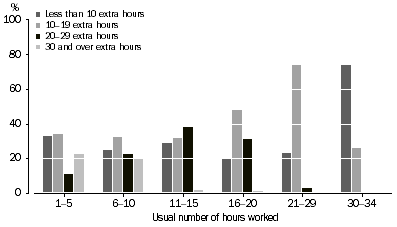SUMMARY OF FINDINGS
OVERVIEW
There were 10,290,000 employed people aged 15 years and over in September 2006. Of these:
- 576,400 (5.6%) usually worked part-time and would have preferred to work more hours
- 544,600 (5.3%) were underemployed workers, comprising:
- 483,900 who usually worked part-time but would prefer more hours and were available to start work with more hours either in the reference week, or in the four weeks subsequent to the interview
- 60,600 who usually worked full-time but worked part-time hours in the reference week due to economic reasons (being stood down, on short time, or having insufficient work). The majority (82%) of these were men.
Underemployed workers are an important component of underutilised labour resources in the economy, capturing a dimension of such resources not available from the unemployment rate alone. In September 2006 the underemployment rate (underemployed workers as a percentage of the total labour force) was 5.0%. When this is added to the unemployment rate for the same period (4.8%), the result is the labour force underutilisation rate (9.8%), which provides a broader indication of the proportion of the population affected by labour underutilisation. The labour force underutilisation rate has continued to decrease from 12.6% in September 2001 to 9.8% in September 2006.
PART-TIME WORKERS WHO WOULD PREFER MORE HOURS
In September 2006, there were 2,903,200 part-time workers. Of these, 576,400 (20%) would have preferred to work more hours compared with 612,000 (22%) in September 2005. The number of female part-time workers who would prefer to work more hours has decreased from 401,200 (20%) in September 2005 to 356,100 (17%) in September 2006. Over this period the proportion of men who would prefer to work more hours has remained fairly constant (26% and 27% respectively).
Of the part-time workers who would prefer to work more hours, the majority (57%) would prefer to work full-time. For men, the proportion who preferred to work full-time was 71% compared with 48% for women.
UNDEREMPLOYED PART-TIME WORKERS
Underemployed part-time workers are people who usually work less than 35 hours a week, would prefer to work more hours and are available to work more hours. Of the 483,900 underemployed part-time workers, 57% (274,600) had looked for work with more hours at some time during the four weeks up to the end of the reference week.
Women made up 61% of underemployed part-time workers, compared with 66% in September 2005. Of those underemployed part-time workers who were women, just over half (157,600 or 53%) were looking for more hours in the reference week or within four weeks.
The median duration of the current period of insufficient work for underemployed part-time workers was 26 weeks. Over one-third (34%) of underemployed part-time workers experienced 52 weeks or more of insufficient work.
Of underemployed part-time workers:
- 44% would prefer to work 10-19 extra hours per week
- 30% would prefer to work less than 10 extra hours per week
- 19% would prefer to work 20-29 extra hours per week; and
- 7% would prefer to work an additional 30 hours or more per week.
The mean preferred number of extra hours each week for underemployed part-time workers was 14.4 hours. Men would prefer to work an average of 15.5 extra hours compared with an average of 13.7 extra hours for women. The mean preferred number of extra hours was lowest for people aged 15-19 years (13.3 hours).
The number of additional hours preferred by part-time workers varied with the number of hours they usually worked. Generally, those usually working fewer hours wanted a greater number of additional hours. However, many did not want to work full-time hours. For example, 78% of those working 1-5 hours a week wanted fewer than 30 additional hours.
Underemployed part-time workers, preferred number of extra hours

Underemployed part-time workers who looked for work with more hours were asked to report their main difficulty in finding work with more hours. The most commonly reported main difficulty in September 2006 was 'no vacancies in line of work' (20%). A further 10% reported 'unsuitable hours' as their main difficulty.
The most common steps taken to find work with more hours were 'contacted prospective employers' (61%), 'looked in newspapers' (58%) and 'asked current employer for more work' (58%).
 Print Page
Print Page
 Print All
Print All